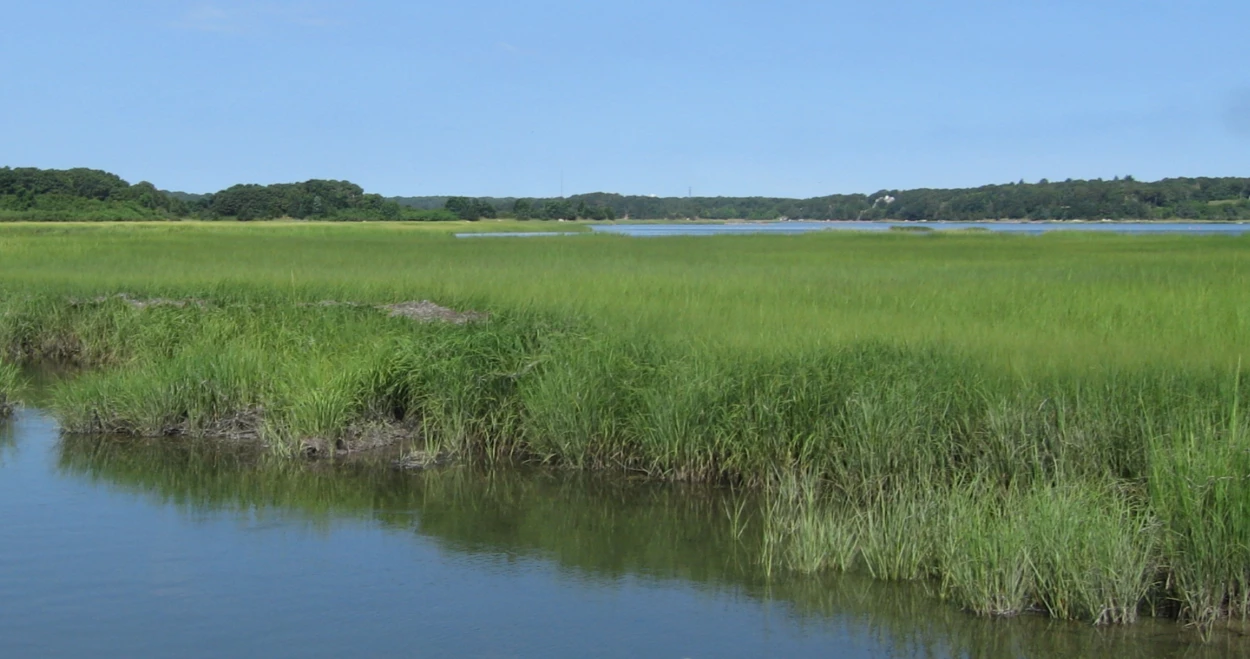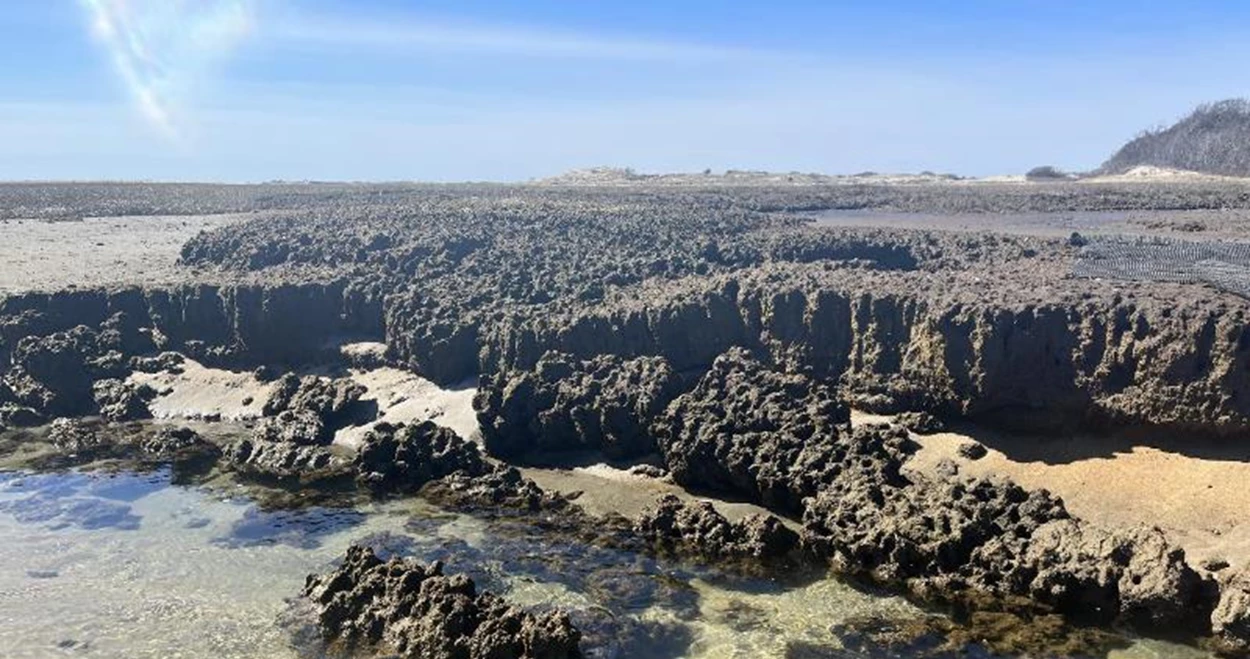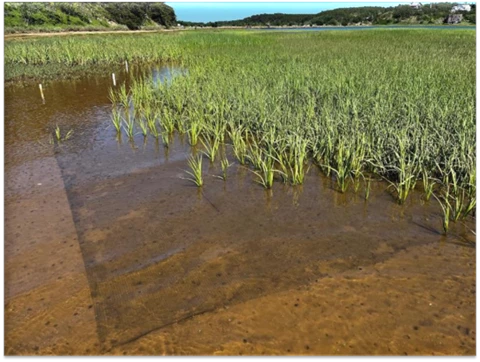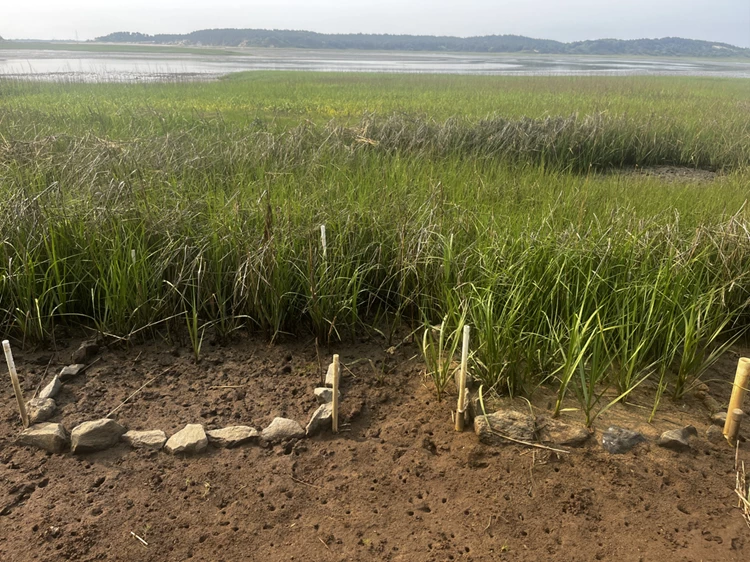


Photo/Stephen Smith, NPS What is Salt Marsh Dieback?The word “dieback” was originally used on Cape Cod to describe areas experiencing an unexplained loss of salt marsh vegetation. In these areas, its often just relic shoot stubble or pieces of roots that are left, with much of the soil around them having been eroded away. In other places, the decayed plant matter in the marsh called “peat” is completely gone as well, and all that remains is a smooth, bare surface. 
Photo/Ed Lilley When did it start?
It turns out, however, that vegetation losses on Cape Cod have been happening for decades. Both low and high marsh vegetation, losses are clear in aerial and ground-level photography as early as 1984. In some marshes, significant widening of creeks without any tidal inlet changes - an indication of vegetation loss from the edges of creeks - can be seen as far back as the 1950s. While individual patches of vegetation may disappear during a single growing season, overall losses are generally cumulative over the course of many years. The dying plants themselves are also difficult to see. 
Photo/Robert Bachand What causes it?

Photo/Mark Bertness, Brown University The research team used cages around the vegetation that the crabs could not get through. The plants protected by the cages, and were thus not fed on, grew up tall and healthy, whereas those that were not protected were frequently grazed down to stubble and died. Other studies revealed that purple marsh crab populations are very high and that they are not often preyed on in Cape marshes. The lack of apparent predators, in addition to other variables such as climate warming and sea level rise, is what has presumably allowed them to become so abundant in this area. How widespread is dieback?

Photo/Benjamin Weihbrecht How does vegetation loss affect salt marshes?

Photo/NPS Areas of marsh stripped bare of vegetation are also subject to a process called soil subsidence, meaning that the ground is sinking. This situation combines poorly with the rates of sea level rise and causes the marsh race even faster towards disappearing entirely. What can be done?Sea level rise is happening now. To try and give our marshes as much of a fighting chance as we can, scientists at Cape Cod National Seashore have experimented with several crab exclusion methods, the first being a mesh laid horizontally over the bare surface. The mesh contains holes that are large enough that fiddler crabs can go in and out, but purple marsh crabs cannot. If the mesh is put down in an area that is already bare of vegetation, not much happens. 
Photo/Stephen Smith, NPS 
Photo/Stephen Smith, NPS Relevant Scientific Publications• Bertness, M. D., & Silliman, B. R. (2008). Consumer control of salt marshes driven by human disturbance. Conservation Biology, 22(3), 618-623.• Bertness, M. D., Holdredge, C., & Altieri, A. H. (2009). Substrate mediates consumer control of salt marsh cordgrass on Cape Cod, New England. Ecology, 90(8), 2108-2117. • Bertness, M. D., Brisson, C. P., Bevil, M. C., & Crotty, S. M. (2014). Herbivory drives the spread of salt marsh die-off. PloS one, 9(3), e92916. • Holdredge, C., Bertness, M. D., & Altieri, A. H. (2009). Role of crab herbivory in die‐off of New England salt marshes. Conservation Biology, 23(3), 672-679. • Smith, S. M. (2009). Multi-decadal changes in salt marshes of Cape Cod, Massachusetts: a photographic analysis of vegetation loss, species shifts, and geomorphic change. Northeast Nat, 16, 183-208. • Smith, S. M., & Tyrrell, M. C. (2012). Effects of mud fiddler crabs (Uca pugnax) on the recruitment of halophyte seedlings in salt marsh dieback areas of Cape Cod (Massachusetts, USA). Ecological Research, 27(1), 233-237. • Smith, S. M., Medeiros, K. C., & Tyrrell, M. C. (2012). Hydrology, herbivory, and the decline of Spartina patens (Aiton) Muhl. in outer Cape Cod salt marshes (Massachusetts, USA). Journal of Coastal Research, 28(3), 602-612. • Smith, S. M. Substrate Properties Affect the Recovery of Spartina alterniflora from Drought and Herbivory. In: Carlos Busso (ed), From seed germination to young plants: ecology, growth, and environmental influences, Chapter 6. Nova Publishers. • Smith, S. M., Tyrrell, M. C., & Congretel, M. (2013). Palatability of salt marsh forbs and grasses to the purple marsh crab (Sesarma reticulatum) and the potential for re-vegetation of herbivory-induced salt marsh dieback areas in cape cod (Massachusetts, USA). Wetlands ecology and management, 21, 263-275. • Smith, S. M. (2015). Vegetation change in salt marshes of Cape Cod National Seashore (Massachusetts, USA) between 1984 and 2013. Wetlands, 35(1), 127-136. • Smith, S. M., & Lee, K. D. (2015). The influence of prolonged flooding on the growth of Spartina alterniflora in Cape Cod (Massachusetts, USA). Aquatic Botany, 127, 53-56. • Smith, S. M. (2015). Does loss of salt marsh vegetation caused by a native grapsid crab improve habitat suitability for the Atlantic mud fiddler (Uca pugnax)?. Journal of Crustacean Biology, 35(5), 616-621. • Smith, S. M., & Green, C. W. (2015). Sediment suspension and elevation loss triggered by Atlantic mud fiddler crab (Uca pugnax) bioturbation in salt marsh dieback areas of southern New England. Journal of Coastal Research, 31(1), 88-94. • Smith, S. (2024). The effects of Sesarma reticulatum (L.) herbivory and sea level rise on creek expansion in Cape Cod salt marshes. Continental Shelf Research, 272, 105146. |
Last updated: April 18, 2024
